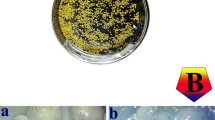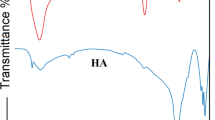Abstract
To address the functional defect of alginate hydrogel in tissue engineering applications, we adopted the interpenetrating polymer network technology as well as the incorporation of SiO2 nanoparticles and the surface coverage of gelatin to fabricate homogeneous oxidized sodium alginate/silica/polyacrylamide–gelatin (OSA/SiO2/PAM-GT) composite hydrogels, using hydroxyapatite/D-glucono-δ-lactone (HAP/GDL) complex as the gelling system. Specially, the effect of SiO2 nanoparticles on the microstructure, mechanical properties, in vitro swelling, biodegradability, biomineralization and biocompatibility of the composite hydrogels was investigated. The resultant OSA/SiO2/PAM-GT composite hydrogels exhibited relatively regular 3D morphology with well-developed pore structure with HAP/GDL as the cross-linking agents. The incorporation of SiO2 nanoparticles could effectively regulate the pore structure, mechanical properties, swelling ratio, in vitro biodegradability and biomineralization of OSA/SiO2/PAM-GT composite hydrogels. Meanwhile, the OSA/SiO2/PAM-GT composite hydrogels could also support the adhesion, proliferation and differentiation of MG-63 cells, which could be applied to the tissue engineering field.









Similar content being viewed by others
Data availability
The raw/processed data required to reproduce these findings cannot be shared at this time due to technical or time limitations.
References
Khan F, Ahmad SR (2013) Polysaccharides and their derivatives for versatile tissue engineering application. Macromol Biosci 13(4):395–421
Venkatesan J, Bhatnagar I, Manivasagan P, Kang KH, Kim SK (2015) Alginate composites for bone tissue engineering: a review. Int J Biol Macromol 72:269–281
Yan HQ, Chen XQ, Li JC, Feng YH, Shi ZF, Wang XH, Lin Q (2016) Synthesis of alginate derivative via the Ugi reaction and itscharacterization. Carbohydr Polym 136:757–763
Bidarra SJ, Barrias CC, Granja PL (2014) Injectable alginate hydrogels for cell delivery in tissue engineering. Acta Biomater 10:1646–1662
Farokhi M, Shariatzadeh FJ, Solouk A, Mirzadeh H (2020) Alginate based scaffolds for cartilage tissue engineering: a review. Int J Polym Mater 69:230–247
Zheng A, Cao L, Liu Y, Wu J, Zeng D, Hu L, Zhang X, Jiang X (2018) Biocompatible silk/calcium silicate/sodium alginate composite scaffolds for bone tissue engineering. Carbohydr Polym 199:244–255
Wu S, Liu X, Yeung KWK, Liu C, Yang X (2014) Biomimetic porous scaffolds for bone tissue engineering. Mater Sci Eng R 80:1–36
Turco G, Marsich E, Bellomo F, Semeraro S, Donati I, Brun F, Grandolfo M, Accardo A, Paoletti S (2009) Alginate/hydroxyapatite biocomposite for bone ingrowth: a trabecular structure with high and isotropic connectivity. Biomacromol 10(6):1575–1583
Ionita M, Pandele MA, Iovu H (2013) Sodium alginate/graphene oxide composite films with enhanced thermal and mechanical properties. Carbohydr Polym 94:339–344
Hernández-González AC, Téllez-Jurado L, Rodríguez-Lorenzo LM (2020) Alginate hydrogels for bone tissue engineering, from injectables to bioprinting: a review. Carbohydr Polym 229:115514
Li Q, Liu CG, Huang ZH, Xue FF (2011) Preparation and characterization of nanoparticles based on hydrophobic alginate derivative as carriers for sustained release of vitamin D3. J Agric Food Chem 59:1962–1967
Shah N, Ul-Islam M, Khattak WA, Park JK (2013) Overview of bacterial cellulose composites: a multipurpose advanced material. Carbohydr Polym 98:1585–1598
Alizadeh N, Celestine AN, Auad ML, Agrawal V (2021) Mechanical characterization and modeling stress relaxation behavior of acrylic–polyurethane-based graft-interpenetrating polymer networks. Polym Eng Sci 61:1299–1309
Naseri N, Deepa B, Mathew AP, Oksman K, Girandon L (2016) Nanocellulose-based interpenetrating polymer network (IPN) hydrogels for cartilage applications. Biomacromol 17:3714–3723
Darnell M, Sun J, Mehta M, Johnson C, Arany P, Suo Z, Mooney D (2013) Performance and biocompatibility of extremely tough alginate/polyacrylamide hydrogels. Biomaterials 34:8042–8048
Sun J, Zhao X, Illeperuma W, Chaudhuri O, Oh KH, Mooney D, Vlassak JJ, Suo Z (2012) Highly stretchable and tough hydrogels. Nature 489:133–136
Fitzgerald MM, Bootsma K, Berberich JA, Sparks JL (2015) Tunable stress relaxation behavior of an alginate-polyacrylamide hydrogel: comparison with muscle tissue. Biomacromol 16:1497–1505
Chen Y, Zhou Y, Liu W, Pi H, Zeng G (2019) POSS hybrid robust biomass IPN hydrogels with temperature responsiveness. Polymers 11(3):524
Li Z, Barnes JC, Bosoy A, Stoddart JF, Zink JI (2012) ChemInform abstract: mesoporous silica nanoparticles in biomedical applications. ChemSoc Rev 41(7):2590–2605
Gribova V, Auzely-Velty R, Picart C (2012) Polyelectrolyte multilayer assemblies on materials surfaces: from cell adhesion to tissue engineering. Chem Mater 24:854–869
Lee H, Hwang H, Kim Y, Jeon H, Kim GH (2014) Physical and bioactive properties of multi-layered PCL/silica composite scaffolds for bone tissue regeneration. Chem Eng J 250:399–408
Ha SW, Viggeswarapu M, Habib MM, BeckJr GR (2018) Bioactive effects of silica nanoparticles on bone cells are size, surface, and composition dependent. Acta Biomater 82:184–196
Beck GR, Ha SW, Camalier CE, Yamaguchi M, Li Y, Lee JK, Weitzmann MN (2012) Bioactive silica-based nanoparticles stimulate bone-forming osteoblasts, suppress bone-resorbing osteoclasts, and enhance bone mineral density in vivo. Nanomed-Nanotechnol 8(6):793–803
Weitzmann MN, Ha SW, Vikulina T, Roser-Pages S, Lee JK, Beck GR (2015) Bioactive silica nanoparticles reverse age-associated bone loss in mice. Nanomed-Nanotechnol 11(4):959–967
Pattanashetti NA, Viana T, Alves N, Mitchell GR (2020) Development of novel 3D scaffolds using BioExtruder by varying the content of hydroxyapatite and silica in PCL matrix for bone tissue engineering. J Polym Res 27(4):1–13
Lu L, Zhang P, Cao Y, Lin Q, Pang SJ (2009) Study on partially oxidized sodium alginate with potassium permanganate as the oxidant. J Appl Polym Sci 113(6):3585–3589
Mao S, Zhang T, Sun W, Ren X (2012) The depolymerization of sodium alginate by oxidative degradation. Pharm Dev Technol 17(6):763–769
Yue W, Zhang HH, Yang ZN, Xie Y (2021) Preparation of low-molecular-weight sodium alginate by ozonation. Carbohydr Polym 251:117104
Falkeborg M, Cheong LZ, Gianfico C, Sztukiel KM, Kristensen K, Glasius M, Xu X, Guo Z (2014) Alginate oligosaccharides: enzymatic preparation and antioxidant property evaluation. Food Chem 164:185–194
Gomez CG, Rinaudo M, Villar MA (2007) Oxidation of sodium alginate and characterization of the oxidized derivatives. Carbohydr Polym 67:296–304
Tchobanian A, Oosterwyck HV, Fardim P (2019) Polysaccharides for tissue engineering: current landscape and future prospects. Carbohydr Polym 205:601–625
Su K, Wang C (2015) Recent advances in the use of gelatin in biomedical research. Biotechnol Lett 37:2139–2145
Gungor M, Sagirli MN, Calisir MD, Selcuk S, Kilic A (2021) Developing centrifugal spun thermally cross-linked gelatin based fibrous biomats for antibacterial wound dressing applications. Polym Eng Sci 61:2311–2322
Bernstein-Levi O, Ochbaum G, Bitton R (2016) The effect of covalently linked RGD peptide on the conformation of polysaccharides in aqueous solutions. Colloid Surf B 137:214–220
Chen X, Yan H, Bao C, Zhu Q, Liu Z, Wen Y, Li Z, Zhang T, Lin Q (2022) Fabrication and evaluation of homogeneous alginate/polyacrylamide–chitosan–gelatin composite hydrogel scaffolds based on the interpenetrating networks for tissue engineering. Polym Eng Sci 62(1):116–128
Wang H, Chen X, Wen Y, Li D, Sun X, Liu Z, Yan H, Lin Q (2022) A study on the correlation between the oxidation degree of oxidized sodium alginate on its degradability and gelation. Polymers 14:1679
Yang CH, Wang MX, Haider H, Yang JH, Sun JY, Chen YM, Zhou JX, Suo ZG (2013) Strengthening alginate/polyacrylamide hydrogels using various multivalent cations. ACS Appl Mater Interfaces 5:10418–10422
Liu YS, Huang QL, Feng QL (2013) 3D scaffold of PLLA/pearl and PLLA/nacre powder for bone regeneration. Biomed Mater 8:065001–065009
Yan H, Chen X, Bao C, Wu S, He S, Lin Q (2020) Alginate derivative-functionalized silica nanoparticles: surface modification and characterization. Polym Bull 77:73–84
Islam MS, Karim MR (2010) Fabrication and characterization of poly (vinyl alcohol)/alginate blend nanofibers by electrospinning method. Colloid Surf A 366:135–140
Yang JS, Ren HB, Xie YJ (2011) Synthesis of amidic alginate derivatives and their application in microencapsulation of λ-cyhalothrin. Biomacromol 12:2982–2987
Yan HQ, Chen XQ, Feng MX, Shi ZF, Zhang W, Wang Y, Ke CR, Lin Q (2019) Entrapment of bacterial cellulose nanocrystals stabilized Pickering emulsions droplets in alginate beads for hydrophobic drug delivery. Colloid Surf B 177:112–120
Li Z, Chen X, Bao C, Liu C, Liu C, Li D, Yan H, Lin Q (2021) Fabrication and evaluation of alginate/bacterial cellulose nanocrystals-chitosan-gelatin composite scaffolds. Molecules 26:5003
Yan H, Chen X, Bao C, Yi J, Lei M, Ke C, Zhang W, Lin Q (2020) Synthesis and assessment of CTAB and NPE modified organomontmorillonite for the fabrication of organo-montmorillonite/alginate based hydrophobic pharmaceutical controlled-release formulation. Colloid Surf B 191:110983
Liu M, Dai L, Shi H, Xiong S, Zhou C (2015) In vitro evaluation of alginate/halloysite nanotube composite scaffolds for tissue engineering. Mater Sci Eng C 49:700–712
Valente JFA, Valente TAM, Alves P, Ferreira P, Silva A, Correia IJ (2012) Alginate based scaffolds for bone tissue engineering. Mater Sci Eng C 32:2596–2603
Sowjanya JA, Singh J, Mohita T, Sarvanan S, Moorthi A, Srinivasan N, Selvamurugan N (2013) Biocomposite scaffolds containing chitosan/alginate/nano-silica for bone tissue engineering. Colloid Surf B 109:294–300
Chen F, Tian M, Zhang D, Wang J, Wang Q, Yu X, Zhang X, Wan C (2012) Preparation and characterization of oxidized alginate covalently cross-linked galactosylated chitosan scaffold for liver tissue engineering. Mater Sci Eng C 32(2):310–320
Shi XT, Wang YJ, Ren L, Zhao NR, Gong YH, Wang DA (2009) Novel mesoporous silica-based antibiotic releasing scaffold for bone repair. Acta Biomater 5:1697–1707
Lewandowska-Łańcucka J, Mystek K, Mignon A, Vlierberghe SV, Łatkiewicz A, Nowakowska M (2017) Alginate- and gelatin-based bioactive photocross-linkable hybridmaterials for bone tissue engineering. Carbohydr Polym 157:1714–1722
Domingues RMA, Gomes ME, Reis RL (2014) The potential of cellulose nanocrystals in tissue engineering strategies. Biomacromol 15:2327–2346
Pattanashetti NA, Biscaia S, Moura C, Mitchell GR, Kariduraganavar MY (2019) Development of novel 3D scaffolds using BioExtruder by the incorporation of silica into polycaprolactone matrix for bone tissue engineering. Mater Today Commun 21:100651
Yang X, Li Y, Liu X, Huang Q, He W, Zhang R, Feng Q, Benayahu D (2016) The stimulatory effect of silica nanoparticles on osteogenic differentiation of human mesenchymal stem cells. Biomed Mater 12(1):015001
Shie MY, Ding SJ, Chang HC (2011) The role of silicon in osteoblast-like cell proliferation and apoptosis. Acta Biomater 7(6):2604–2614
Ge C, Xiao G, Jiang D, Franceschi RT (2007) Critical role of the extracellular signal–regulated kinase–MAPK pathway in osteoblast differentiation and skeletal development. J Cell Biol 176(5):709–718
Acknowledgements
We gratefully thank the financial support from the National Natural Science Foundation of China (51963009), the Natural Science Foundation of Hainan Province (220MS035), the Open Fund for Innovation and Entrepreneurship of College Students of Hainan Normal University (hscy2022-14), the Innovation and Scientific Research Projects for Undergraduates of Hainan Province and the Innovation and Scientific Research Projects for Undergraduates of Hainan Normal University (hscx2022-30).
Author information
Authors and Affiliations
Corresponding author
Ethics declarations
Conflict of interest
There are no conflicts to declare.
Additional information
Publisher's Note
Springer Nature remains neutral with regard to jurisdictional claims in published maps and institutional affiliations.
Supplementary Information
Below is the link to the electronic supplementary material.
Rights and permissions
Springer Nature or its licensor (e.g. a society or other partner) holds exclusive rights to this article under a publishing agreement with the author(s) or other rightsholder(s); author self-archiving of the accepted manuscript version of this article is solely governed by the terms of such publishing agreement and applicable law.
About this article
Cite this article
Li, D., Liao, Y., Chen, X. et al. Preparation and properties of homogeneous oxidized sodium alginate/silica/polyacrylamide–gelatin composite hydrogel based on interpenetrating network technology. Polym. Bull. 80, 11899–11917 (2023). https://doi.org/10.1007/s00289-022-04631-2
Received:
Revised:
Accepted:
Published:
Issue Date:
DOI: https://doi.org/10.1007/s00289-022-04631-2




